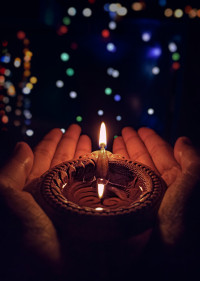As it is
Ode to the streets of Patan
When I moved to Patan three months ago, it took me a while to discover all the graffiti scattered. But thanks to that art, I learnt to see Patan through a different lens..jpg&w=900&height=601)
Gina Bachmann
She has a bright smile on her face but what might she be looking at? Her head turned to the right, she faces Dhalaacha Road, the busy street between Patan Dhoka and Swotha. Motorbikes are rushing by, dust is whirling up, school children are walking past her, giggling, and a fat stray dog is lurking around. A few tourists stand wearing cameras around their necks like medals or necklaces, some of them seemingly lost, some of them visibly enjoying the liveliness of that spot. She might have noticed that one tourist, a woman of around 25 years, approaching her and clicking many pictures. But she didn’t get annoyed. Whatever good or bad happens in that street, whatever she witnesses, she remains silent.
The lady on the yellow circle was one of the first murals I spotted after moving to Patan three months ago. Although I walked past her every day on my way to work, it took me quite a while to fully appreciate this piece of art. During my first few weeks of living in Patan, I was mostly focused on the traffic, navigating my way through the crowd, trying not to get hit by a bike or stumble over a pothole, oftentimes following Google Maps on my phone.
After a while, I became familiar with the place. And then I saw the temples, the beautiful architecture, the stupas, and the nicely coloured doors.
It’s not that I don’t like busy places. Although I grew up in a rural place on the brinks of the Swiss alps, I always felt naturally drawn to cities. I love their capability of surprising us, of challenging us. And I love the chaos and randomness of cities, the mosaic of stories and people that shape them without anybody having control. Also, I'm usually quite good at adjusting to new places. But Patan proved a bit of a challenge in this regard. I remember always feeling very tired when I got home.
But only a few weeks ago, something in the way I perceived Patan changed. It was a sunny Saturday morning and I wanted to walk to Pimbahal Pukhu, the big pond near Patan Dhoka. I left the house and, after a few minutes, I felt like graffiti popped up on every corner I passed. It was as if a big street art festival had taken place overnight. In fact, the murals were flaking and looked old. I took my camera out of my backpack and slowed my pace. One piece of graffiti, of a serious-looking girl with big glasses, was just behind my house. There was another of a couple standing close together on a red facade, a man holding an umbrella in his right hand. Another was of a little boy holding a globe in his hands like a crystal ball. There was a huge mural of at least 12 square-metres just a few minutes from where I stayed. And there was the lady on the big yellow circle whom I had already come to know. For the first time, I realised how happy she looked. I figured she must be looking at somebody she likes.
When I reached the pond after about one and a half hours, I felt a little tired but also very relaxed and happy. I ordered a milk tea in one of the cafés and wondered how it was possible that I haven’t seen all that graffiti and all those murals before, especially being a great street art lover. I once spent three months in Bristol, in the UK, where famous street artist Banksy comes from. And just like in Bristol, street art again invited me to view this city with very different eyes. Once you start searching for graffiti, the main sights become irrelevant. Each one spotted is like a little gift. A free-of-cost art piece. The city becomes a huge open museum and the grey walls, the black pipes, the windows, the sidewalks and peeling facades become the perfect frame. It's the surroundings that complete a piece of street art. And in the case of Patan, the ancient Newar architecture together with the modern and funky murals produce an exciting contrast.
By marvelling at the street art pieces in Patan, I also became aware of how much of this city’s charm lies in the details: the wood carvings on the balconies, the intense orange of the marigold garlands matching so well with the dark wood of the door frames, the random patterns the black cables scribble onto the blue sky. And as I started to look up to spot more murals I became interested in rooftops as well. It seems that the trees and flowers that once had been cut to make way for roads, sidewalks and houses now grow a few floors above, bringing some green back to the city. The random mix of colours on the washing lines and prayer flags complete the colourfulness of Patan’s rooftops.
So, to put in a cheesy way, I fell in love with Patan that Saturday morning. I didn't mind its flaws anymore; the dust, the litter, the noise, the broken pavement.
I think, at the beginning of my stay, I saw Patan with the eyes of someone who visits that place for a day or two and then runs off to the next destination. But it always takes time for the mind to adjust to a place and let all the different impressions sink in. Patan is not just ‘pretty’, as I thought in the beginning. Patan is a beauty with its very own pride and charm hidden in its many wonderful details. So, going back to Switzerland and getting used to Swiss cities will again pose yet another challenge. The Swiss obsession with cleanliness and regulation produces a high quality of life but also a lot of boredom, conformity, and predictability. Those are not really what I’m looking for in cities, but who knows, maybe I will spot a few new murals there as well.
I just hope that if one day I get back to Patan and I walk down Dhalaacha Road, the lady in the yellow circle will still be there, a witness of all the change, the good and bad, and still silently smiling.




 10.12°C Kathmandu
10.12°C Kathmandu










